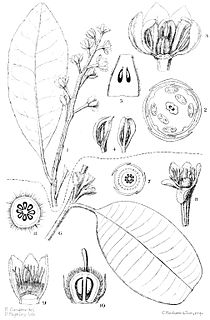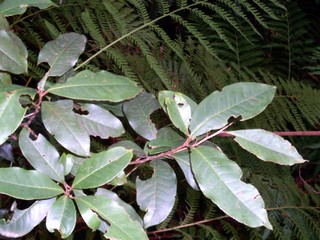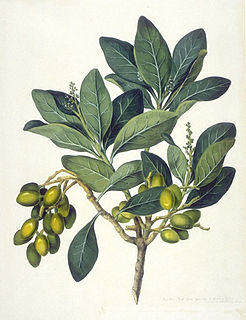
The Australasian realm is a biogeographic realm that is coincident, but not synonymous, with the geographical region of Australasia. The realm includes Australia, the island of New Guinea, and the eastern part of the Indonesian archipelago, including the island of Sulawesi, the Moluccan islands and islands of Lombok, Sumbawa, Sumba, Flores, and Timor, often known as the Lesser Sundas.

The Vanuatu rain forests are tropical and subtropical moist broadleaf forests ecoregion which includes the islands of Vanuatu, as well as the Santa Cruz Islands group of the neighboring Solomon Islands. It is part of the Australasian realm, which includes neighboring New Caledonia and the Solomon Islands, as well as Australia, New Guinea, and New Zealand.

Mekosuchinae is an extinct subfamily of crocodylids from Australia and the South Pacific. They first appear in the fossil record in the Eocene in Australia, and survived until the arrival of humans: in the Pleistocene in Australia and within the Holocene in the Pacific islands of Fiji, New Caledonia and Vanuatu. There is however disagreement on whether or not Mekosuchinae is a true subfamily within Crocodylidae, or a distinct crocodilian family in its own right, Mekosuchidae, within the superfamily Crocodyloidea.

Callitris is a genus of coniferous trees in the Cupressaceae. There are 16 recognized species in the genus, of which 13 are native to Australia and the other three native to New Caledonia. Traditionally, the most widely used common name is cypress-pine, a name shared by some species of the closely related genus Actinostrobus.

Myoporum is a genus of flowering plants in the figwort family, Scrophulariaceae. There are 30 species in the genus, eighteen of which are endemic to Australia although others are endemic to Pacific Islands, including New Zealand, and one is endemic to two Indian Ocean islands. They are shrubs or small trees with leaves that are arranged alternately and have white, occasionally pink flowers and a fruit that is a drupe.

Balanops is a group of flowering plants described as a genus in 1871. The nine species are trees or shrubs, found in New Caledonia, Fiji, Vanuatu, and northern Queensland. They are dioecious, with separate male and female plants.

Homalanthus is a plant genus of the family Euphorbiaceae first described as a genus in 1824. It is the only genus in subtribe Carumbiinae. The genus is native to tropical Asia, Australia, and various islands in the Pacific.

Baloghia is a genus of plants under the family Euphorbiaceae first described as a genus in 1833. It is native to Australia, New Caledonia, and Vanuatu. Cocconerion is a close relative.

Earina is a genus of orchids. AT the present time, 7 species are recognized, native to various islands in the Pacific Ocean.
The Oceania Continent Handball Federation (OCHF) is the governing body for the Olympic sport of Handball in Oceania. It is affiliated to the International Handball Federation (IHF).

Sphenostemon is the genus of small evergreen trees or shrubs native to New Guinea, Queensland (Australia) and New Caledonia. They have opposite or spiral leaves, and at most small stipules. The small flowers, borne in terminal inflorescences, have free sepals and petals. The anthers have thick filaments. The fruit, a berry, is fleshy and contains two seeds. The genus is described as "particularly poorly known".

Kermadecia is a genus of flowering plants in the family Proteaceae. The genus comprises five species, all endemic to New Caledonia. Its closest relatives are Sleumerodendron and Turrillia, of which the species have once been placed in Kermadecia.

Lepidosperma is a genus of flowering plant of the family Cyperaceae. Most of the species are endemic to Australia, with others native to southern China, southeast Asia, New Guinea, New Caledonia and New Zealand.

Parsonsia is a genus of woody vines in the family Apocynaceae. Species occur throughout Indomalaya, Australasia and Melanesia.

The Paracryphiaceae are a family of woody shrubs and trees native to Australia, southeast Asia, and New Caledonia. In the APG III system of 2009, the family is placed in its own order, Paracryphiales, in the campanulid clade of the asterids. In the earlier APG II system, the family was unplaced as to order and included only Paracryphia.

Corynocarpus is the only genus of plants in the family Corynocarpaceae and includes five species. It is native to New Guinea, Australia, New Zealand, New Caledonia, and Vanuatu.

Genoplesium commonly known as midge orchids, is a genus of about 50 species of flowering plants in the orchid family, Orchidaceae and is found in Australia, New Zealand and New Caledonia. Midge orchids are terrestrial herbs with a single leaf at the base of the plant. They are similar to orchids in the genus Prasophyllum in that plants without flowers have a hollow, onion-like leaf. The flowers are small but often scented and attractive to their insect pollinators. There is disagreement about which species belong to this genus and some taxonomists suggest that most belong in the genus Corunastylis.
Gunnarella is a genus of flowering plants from the orchid family, Orchidaceae. It and another orchid genus, Seidenfadenia, are named for Danish botanist Gunnar Seidenfaden. It contains 10 known species, native to New Guinea, New Caledonia and to other nearby islands in the Pacific.
- Gunnarella aymardii(N.Hallé) Senghas - New Caledonia
- Gunnarella begaudii(N.Hallé) Senghas - New Caledonia
- Gunnarella brigittae(N.Hallé) Senghas - New Caledonia
- Gunnarella carinata(J.J.Sm.) Senghas - New Guinea
- Gunnarella florenciae(N.Hallé) Senghas - New Caledonia
- Gunnarella gracilis(Schltr.) Senghas - New Guinea
- Gunnarella laxa(Schltr.) Senghas - Papua New Guinea to Solomon Islands
- Gunnarella nambanaB.A.Lewis - Vanuatu
- Gunnarella neocaledonica(Rendle) Senghas - New Caledonia
- Gunnarella robertsii(Schltr.) Senghas - New Caledonia, New Guinea, Vanuatu, Solomon Islands

Gossia is a genus of rainforest trees in the myrtle family first described as a genus in 2003. It is native to northeastern Australia as well as several islands of Papuasia and New Caledonia.

Quintinia serrata, the tawheowheo, is a species of evergreen trees in the genus Quintinia endemic to New Zealand.

















